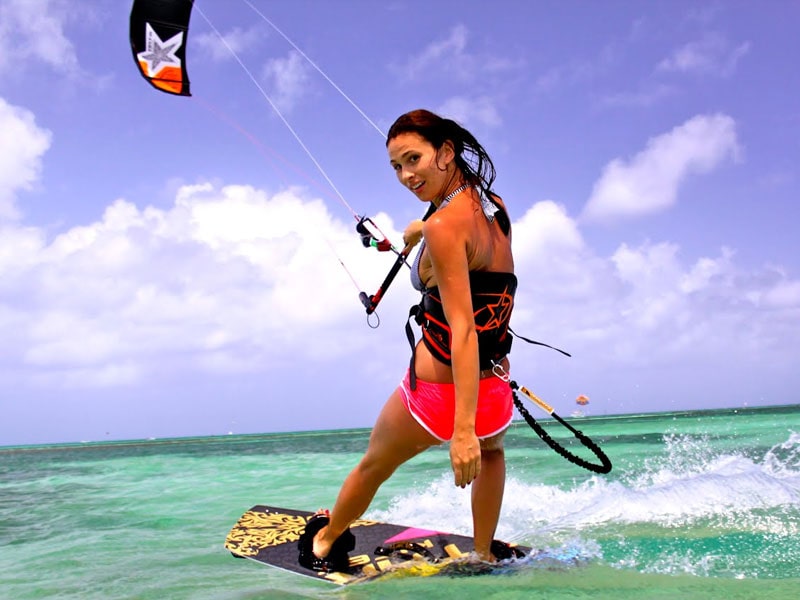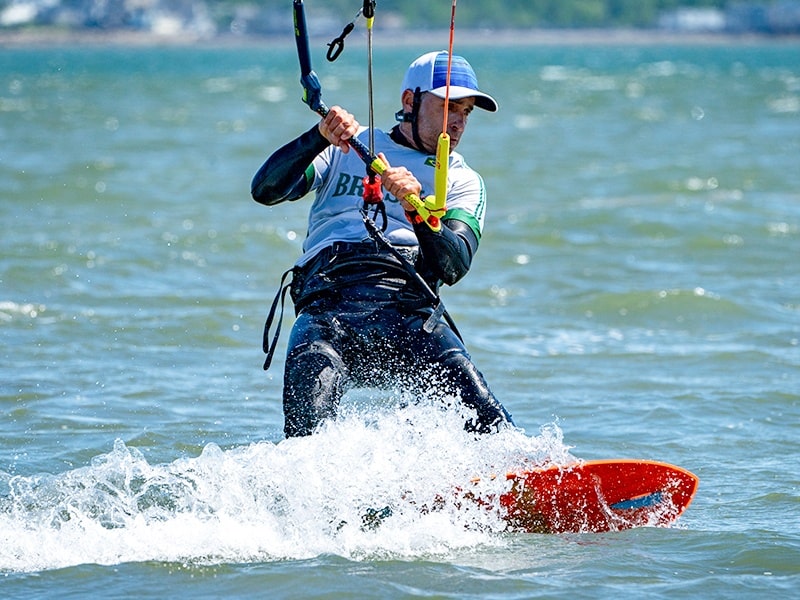
Kitesurfing: stages of taking the inevitable
Eight years ago, kitesurfing (also known as kiteboarding) was an unpopular extreme sport that few people in Russia knew about. Surprisingly, the situation has not changed much even now.
Yes, several kite-shops have opened, a popular cellular operator used kites on billboards, but… that’s all. People without adrenaline addiction still do not know what kind of animal it is, and why these people on the water tied the parachute to themselves.
And even those who know poorly how to approach this complex construction.
And that’s because kitesurfing is an expensive outfit and quite a long training period. And only then – complete freedom, unity with the wind, air and water. And also – a completely free gurney with no time or location restrictions.
What is this? What is this?
From the outside it looks like a man tied directly to a parachute. In fact, it’s a little more humane.
A kitesurfer is a board, a trapeze on a belt, a bar attached to a trapeze with a hook, and actually a sling and kite (the same parachute). About two safety systems, a stroporez and a dipauer now we will not be, and without them all looks difficult.
Thus, the kite does not hold its “parachute” in its hands, it rather works as an anchor for it. Hands remain free, their task is to pull the kite by the slings, forcing the kite to fold “ears”, to gather more or less air. Actually, this way you can change the traction and direction of movement and move in almost any direction of the wind window.
The kite itself is basically a big kite with inflatable ribs. They will have to be inflated before each gurney again.
Until recently, a mandatory part of the kitesurfer equipment were shorts, held on the hips with the power of thought. But times are changing, now kite fashion has become kinder and more humane.
What is parafoil and what does surfing have to do with it?
The kite industry is evolving very quickly. The shape of the kite changes, the number of slings, the mechanism of inflating the kite. And the difference between the old and new generations is really noticeable, as between the machine on the mechanics and on the automatic machine.
Apart from the usual “inflatable” – a kite, which keeps its shape at the expense of air cylinders – there are parafoils. Usually they are larger, but you don’t have to inflate them: the parafoils keep their shape at the expense of the air contained inside them by the valve system. They look epic, but they are said not to be very adapted to water: they can get bread and no longer fly up.
Boards can also be different. A classic variant is a symmetrical board with fins. Legs are inserted into pads – soft fasteners. A variant for the sophisticated is a surfer. Looks like a surfer, and behaves the same way. Rigid riders also use boards with rigid fixing fasteners. But that’s all – the next level of evolution.
How do I get started?
While you’re studying, kitesurfing will make you go through all five classic stages of accepting the inevitable.
Denial
You just don’t understand how that can be. Snowboarding, skateboarding, burning courses, MSU diploma and meditation every night… all this doesn’t work when you have a kite bar in your hand. Because he has his own opinion about any action of a petty man, fastened from below.

Anger
The first time you do it, it’s like one person in 20. And this man is terribly annoying. As well as the instructor, over and over again offers to do things that entail not the most pleasant consequences for the slightest mistake. For example, flying over the water almost without touching or exercise for a man-calamar (it is a bodiedrag, about this later). It also makes you angry that the wind is not the right one, the kite does not listen, the board does not go.
Bidding
At some point, it seems that this bastard upstairs is animated and completely intelligent. And his goal is to make fun of pathetic people. But attempts to come to terms with the world don’t work either.
Depression
Kite can drive even the toughest of them. When neither anger, nor persuasion, nor attempts at rationalization work, all that remains is to accept one’s own failure and sit on the shore in despair. And then return to the water once again to consolidate the failure.
Acceptance
It is at this stage that a breakthrough usually occurs. When you are completely calm, when the result is no longer important (it is clear that it is fatalitis). You just try again and – hoba! – The kite listens, the board goes and even edges… It’s not a mystic, it’s just kite surfing – it’s about relaxation and concentration on the current moment. No matter how hipsterish it sounds.
Stages of training
Pump it!
The first step is to learn how to unfold the slings and pump the kite. So far – nothing complicated, besides perfectly pumping gluteal muscles.
Piloting
You are fastened to a small kite, behind the instructor as a counterweight.
It is not necessary to accept offers to play on a lesson with “pilotage” (absolutely small kajt, intended for training it is not clear who). The sling fixing and the bar are completely different, and he reacts to the actions of a person in a different way than the “adult” kite. If you want to play with something flying, it is better to buy yourself a beautiful kite – it will be as useful.
Squid Man
The second stage of training is bodiedrag. And it’s probably the most applied of all the presenters. A bodiedrag teaches you how to cut upwind without a board, using your body as a fin (or board edge, if that’s more understandable).
The trouble is that a person has a mouth and a nose: holes through which water gets in with acceleration from the pulling kite. Beginners usually have no control over their body position over the water, so they have the hardest time coming back from the water, feeling like a whale with bulimia, having had a hard time eating plankton.
But the bodiedrag itself is a very useful skill. And not only because it teaches you how to manage a kite “in battle”. Simply in the future you will repeatedly lose the board: this leads to almost every fall or unsuccessful jump.
In the seconds that you spit and lift the kite, you will be carried downwind. And the board will be carried away by the current. And you can meet again only if you can cut yourself against the wind.
Board
A stage that opens the way for you to kitesurf. Everything will be much easier and faster from here, you probably won’t even need an instructor.
But now the main thing is to understand how it is possible to do it at all – at the same time to hold the bar, control the kite, not to sink and not to swim under the slings and to put on the board in parallel.
The main rule here is not to brake and not to be gentle with the kite. The longer you hang out under the slings with the board, the less manageable the situation becomes. And it is better to squeeze the bar for the start than not to finish it, at least you will understand what is going to happen, and ideally you will get up on the board at once.






